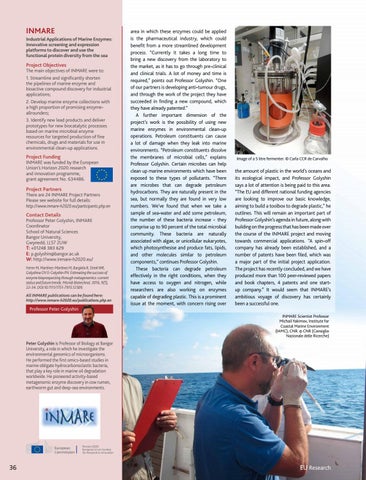INMARE Industrial Applications of Marine Enzymes: Innovative screening and expression platforms to discover and use the functional protein diversity from the sea
Project Objectives
The main objectives of INMARE were to: 1. Streamline and significantly shorten the pipelines of marine enzyme and bioactive compound discovery for industrial applications; 2. Develop marine enzyme collections with a high proportion of promising enzymeallrounders; 3. Identify new lead products and deliver prototypes for new biocatalytic processes based on marine microbial enzyme resources for targeted production of fine chemicals, drugs and materials for use in environmental clean-up applications.
Project Funding
INMARE was funded by the European Union’s Horizon 2020 research and innovation programme, grant agreement No. 634486.
Project Partners
There are 24 INMARE Project Partners Please see website for full details: http://www.inmare-h2020.eu/participants.php.en
Contact Details
Professor Peter Golyshin, INMARE Coordinator School of Natural Sciences Bangor University, Gwynedd, LL57 2UW T: +01248 383 629 E: p.golyshin@bangor.ac.uk W: http://www.inmare-h2020.eu/ Ferrer M, Martínez-Martínez M, Bargiela R, Streit WR, Golyshina OV & Golyshin PN. Estimating the success of enzyme bioprospecting through metagenomics: current status and future trends. Microb Biotechnol. 2016, 9(1), 22-34. DOI:10.1111/1751-7915.12309. All INMARE publications can be found here: http://www.inmare-h2020.eu/publications.php.en
Professor Peter Golyshin
area in which these enzymes could be applied is the pharmaceutical industry, which could benefit from a more streamlined development process. “Currently it takes a long time to bring a new discovery from the laboratory to the market, as it has to go through pre-clinical and clinical trials. A lot of money and time is required,” points out Professor Golyshin. “One of our partners is developing anti-tumour drugs, and through the work of the project they have succeeded in finding a new compound, which they have already patented.” A further important dimension of the project’s work is the possibility of using new marine enzymes in environmental clean-up operations. Petroleum constituents can cause a lot of damage when they leak into marine environments. “Petroleum constituents dissolve the membranes of microbial cells,” explains Professor Golyshin. Certain microbes can help clean up marine environments which have been exposed to these types of pollutants. “There are microbes that can degrade petroleum hydrocarbons. They are naturally present in the sea, but normally they are found in very low numbers. We’ve found that when we take a sample of sea-water and add some petroleum, the number of these bacteria increase - they comprise up to 90 percent of the total microbial community. These bacteria are naturally associated with algae, or unicellular eukaryotes, which photosynthesise and produce fats, lipids, and other molecules similar to petroleum components,” continues Professor Golyshin. These bacteria can degrade petroleum effectively in the right conditions, when they have access to oxygen and nitrogen, while researchers are also working on enzymes capable of degrading plastic. This is a prominent issue at the moment, with concern rising over
Image of a 5 litre fermenter. © Carla CCR de Carvalho
the amount of plastic in the world’s oceans and its ecological impact, and Professor Golyshin says a lot of attention is being paid to this area. “The EU and different national funding agencies are looking to improve our basic knowledge, aiming to build a toolbox to degrade plastic,” he outlines. This will remain an important part of Professor Golyshin’s agenda in future, along with building on the progress that has been made over the course of the INMARE project and moving towards commercial applications. “A spin-off company has already been established, and a number of patents have been filed, which was a major part of the initial project application. The project has recently concluded, and we have produced more than 100 peer-reviewed papers and book chapters, 4 patents and one startup company.” It would seem that INMARE’s ambitious voyage of discovery has certainly been a successful one. INMARE Scientist Professor Michail Yakimov, Institute for Coastal Marine Environment (IAMC), CNR. © CNR (Consiglio Nazionale delle Ricerche)
Peter Golyshin is Professor of Biology at Bangor University, a role in which he investigate the environmental genomics of microorganisms. He performed the first omics-based studies in marine obligate hydrocarbonoclastic bacteria, that play a key role in marine oil degradation worldwide. He pioneered activity-based metagenomic enzyme discovery in cow rumen, earthworm gut and deep-sea environments.
36
EU Research
